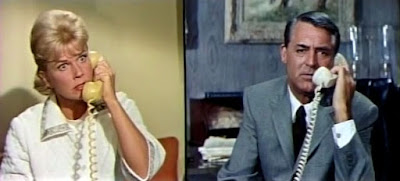Released today back in 1962, That Touch of Mink was Cary Grant's 69th full length feature film.
Summary:
Cast:
Cary Grant..Philip Shayne
Doris Day...Cathy Timberlake
Gig Young...Roger
Audrey Meadows...Connie Emerson
John Astin...Mr. Everett Beasley
Dick Sargent...Young Man (Harry Clark) (as Richard Sargent)
Joey Faye...Short Man
Laurie Mitchell...Showgirl
John Fiedler...Mr. Smith
Willard Sage...Tom Hodges
Jack Livesey...Doctor Richardson
Did You Know?
Doris Day was 39 when this film was made, although her character was supposed to be in her twenties.
Rock Hudson had expected to be cast as Philip, but director Delbert Mann wanted Cary Grant.
In her autobiography, Doris Day wrote: "Of all the people I performed with, I got to know Cary Grant least of all. He is a completely private person, totally reserved, and there is no way into him. Our relationship on That Touch of Mink (1962) was amicable but devoid of give-and-take...Not that he wasn't friendly and polite - he certainly was. But distant. Very distant. But very professional - maybe the most professional, exacting actor I ever worked with. In the scenes we played, he concerned himself with every little detail: clothes, sets, production values, the works. Cary even got involved in helping to choose the kind of mink I was slated to wear in the film."
Cary Grant involved himself in many details of the production. For a scene that took place in his character's library, he arrived to work with boxes of items from the library in his own house and placed them about the set. According to Doris Day, this served not only to make the set more attractive but also made him feel more relaxed and at home, giving his performance "that peculiarly natural, suave quality that is the hallmark of his pictures."
The movie was filmed on location in New York. Some sources claim it was also shot in Bermuda, but others state that the scenes of the Bermuda resort were actually shot at the Fairmont Miramar Hotel in Santa Monica.
Cary Grant was a huge fan of the New York Yankees, which likely made it easier for the producers to get Yogi Berra, Mickey Mantle and Roger Maris to appear in the film.
Quotes:
Cathy Timberlake: [very drunk] Do you like the way I walk?
Philip Shayne: Poetry in motion.
Cathy Timberlake: I learned when I was a baby, been walking for years.
Philip Shayne: The Four Horsemen now have a riding companion. There's War, Famine, Death, Pestilence, and Miss Timberlake!
Cathy Timberlake: Look, he doesn't love me. He just feels sorry for me.
Roger: Doesn't love you? He's compared you to the plague!
Cathy Timberlake: How would you feel? Here I am, he practically runs me down and then drives right away! And doesn't have the decency to apologise himself. Furthermore I have a job interview and have to go like this. He doesn't care.
On set.
Roger: Ohhh...
Cathy Timberlake: You know what I'd like to do?
Roger: Throw the money in his face?
Cathy Timberlake: Exactly! I'd like to throw that money right in his face.
Roger: Would you?
Cathy Timberlake: Yes, I would.
Roger: I've waited seven years for this moment. You come with me!
Philip Shayne: That's it, Roger. Now you have plenty of friends. Find her a husband. A simple, dull, unimaginative man who'll smile tolerantly when he comes home from work and learns she's misplaced the children.
Cathy Timberlake: [Cathy is rushing off to meet Philip, over Connie's objections] Connie, this is terribly important to me. I've got to *prove* to him that I'm a woman!
Connie Emerson: [calls after her] Well, there are easier ways to do it. Send him your birth certificate!
Cathy Timberlake: And I'm unstable. What kind of mother would I make for our children?
Philip Shayne: Well we'll try three or four if that doesn't work out, we'll breed poodles.
Lobby Cards:
Directed by Delbert Mann
Distributed by Universal-International
Produced by Granley Company-Arwin Productions.
Running time: 99 minutes.





















































